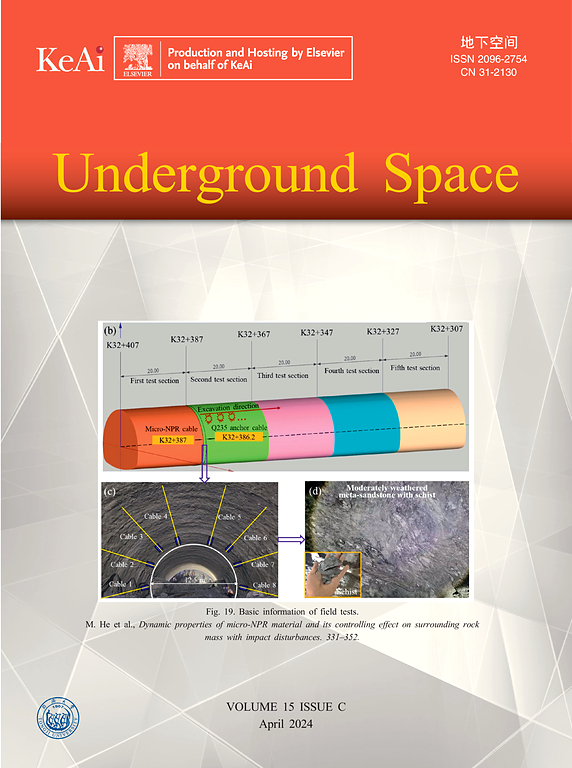Analysis of the dynamic response and damage characteristic for the tunnel under near-field blasts and far-field earthquakes
IF 8.3
1区 工程技术
Q1 ENGINEERING, CIVIL
引用次数: 0
Abstract
The dynamic response and failure characteristics of tunnels vary significantly under various dynamic disturbances. These characteristics are crucial for assessing structural stability and designing effective support for surrounding rock. In this study, the theoretical solution for the dynamic stress concentration factor (DSCF) of a circular tunnel subjected to cylindrical and plane P-waves was derived using the wave function expansion method. The existing equivalent blast stress wave was optimized and the Ricker wavelet was introduced to represent the seismic stress waves. By combining Fourier transform and Duhamel’s integral, the transient response of the underground tunnel under near-field blasts and far-field earthquakes was determined in both the frequency and time domains. The theoretical results were validated by comparing them with those obtained from numerical simulations using ANSYS LS-DYNA software. Numerical simulations were conducted to further investigate the damage characteristics of the underground tunnel and evaluate the effect of initial stress on structural failure under both types of disturbances. The theoretical and numerical simulation results indicated that the differences in the dynamic response and damage characteristics of the underground tunnel were primarily due to the curvature of the stress waves and transient load waveform. The locations of the maximum DSCF values differed between near-field blasts and far-field earthquakes, whereas the minimum DSCF values occurred at the same positions. Without initial stress, the blast stress waves caused spalling damage to the rock mass on the wave-facing side. Shear failure occurred near the areas with maximum DSCF values, and tensile failure occurred near the areas with minimum DSCF values. In contrast, damage occurred only near the areas with maximum DSCF values under seismic stress waves. Furthermore, the initial stress exacerbated spalling and shear damage while suppressing tensile failure. Hence, the blast stress waves no longer induced tensile failure on the tunnel sidewalls under initial stress.
近场爆炸和远场地震作用下隧道动力响应及损伤特征分析
在各种动力扰动下,隧道的动力响应和破坏特征变化很大。这些特征对于结构稳定性评价和设计有效的围岩支护具有重要意义。本文采用波函数展开法,推导了圆柱纵波和平面纵波作用下圆形隧道动应力集中系数的理论解。对现有的等效爆炸应力波进行了优化,并引入Ricker小波来表示地震应力波。将傅里叶变换与Duhamel积分相结合,确定了地下隧道在近场爆炸和远场地震作用下的时域和频域瞬态响应。通过ANSYS LS-DYNA软件的数值模拟,验证了理论计算结果。通过数值模拟,进一步研究了地下隧道在两种扰动下的损伤特征,并评估了初始应力对结构破坏的影响。理论和数值模拟结果表明,地下隧道动力响应和损伤特征的差异主要是由应力波和瞬态荷载波形的曲率引起的。在近场地震和远场地震中,DSCF最大值的位置不同,而最小的DSCF值出现在相同的位置。在没有初始应力的情况下,爆炸应力波对面波侧岩体产生剥落损伤。剪切破坏发生在DSCF最大值附近,拉伸破坏发生在DSCF最小值附近。相反,在地震应力波作用下,破坏仅发生在DSCF值最大的区域附近。此外,初始应力在抑制拉伸破坏的同时加剧了剥落和剪切破坏。因此,在初始应力作用下,爆炸应力波不再引起巷道侧壁的拉破坏。
本文章由计算机程序翻译,如有差异,请以英文原文为准。
求助全文
约1分钟内获得全文
求助全文
来源期刊

Underground Space
ENGINEERING, CIVIL-
CiteScore
10.20
自引率
14.10%
发文量
71
审稿时长
63 days
期刊介绍:
Underground Space is an open access international journal without article processing charges (APC) committed to serving as a scientific forum for researchers and practitioners in the field of underground engineering. The journal welcomes manuscripts that deal with original theories, methods, technologies, and important applications throughout the life-cycle of underground projects, including planning, design, operation and maintenance, disaster prevention, and demolition. The journal is particularly interested in manuscripts related to the latest development of smart underground engineering from the perspectives of resilience, resources saving, environmental friendliness, humanity, and artificial intelligence. The manuscripts are expected to have significant innovation and potential impact in the field of underground engineering, and should have clear association with or application in underground projects.
 求助内容:
求助内容: 应助结果提醒方式:
应助结果提醒方式:


